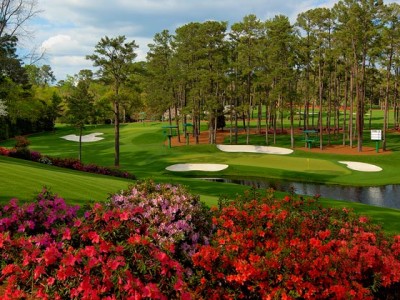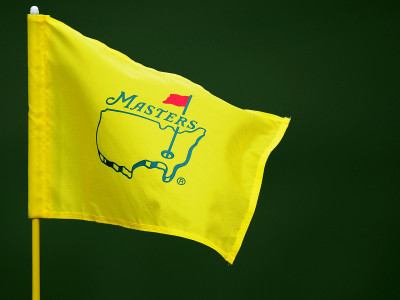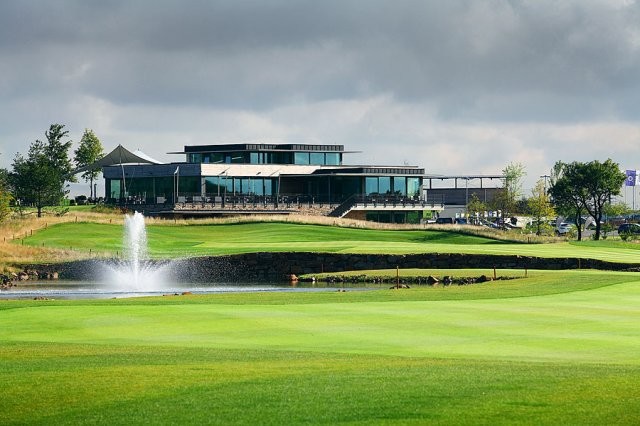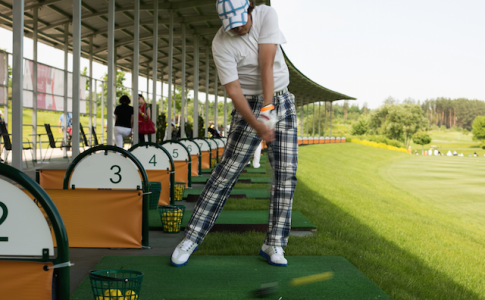David Carter’s shares his view on an 18-hole course at Albatross.
What to be aware of, how to play, where to attack? Get advice.
1st Hole
The first hole at Albatross is a short par 5. A good drive avoiding bunkers on either side of the fairway is very important. The 1st hole will leave the longer hitters a chance to go for the green on second shot. However, be careful, the green is well protected and will need an accurate shot. There are bunkers short left, right and long waiting to grab your ball. Since the green is sloping from back to front and with the pin back left, two putts can be quite difficult.
2nd Hole
A short par 4 is a little downhill with a bunker guarding the left side. Some players prefer to take a 3-wood in order to avoid the ball running through the fairway and into the long grass. Once you have dealt with that you will be left with a mid to short iron to hit the green. The green has no bunkers but still is quite difficult. It is generous in size, but sloping from left to right. Again, accuracy is important.
3rd Hole
This is the first par 3 at Albatross. This long hole plays a little uphill. Players want to avoid missing the green left, as there is long grass and trees to contend with. If you are lucky enough to hit the green, 2 putts is no certainty with a ridge running across the middle of the green. The toughest pin position is short left, as it is really difficult to stop the ball on the green.
4th Hole
A beautiful par 4 set in the valley. Players playing from the back tee will see very little of the fairway due to the tall trees on the left side of the hole. Sometimes it is better to decide to hit a 3-wood to avoid going into the fairway bunker or long grass on the right. Definitely a premium here is hitting this fairway, then a second shot will be a short one to a slightly elevated green. But watch out for a very deep bunker short left and a green that runs off on the left side.
5th Hole
This is a long par 4 going slightly uphill. Do not expect a simple shot from the tee. Bunkers are left and right and if you are a long way left, the dreaded “out of bounds” awaits. The second shot played from a little upslope will help you to stop the ball to a green protected by a pot bunker on the left and a huge bunker on the right. The big green with a ridge running across the middle makes putting a little tricky depending on where the pin is placed. I consider par on this hole a fantastic score.
6th Hole
A lovely short par 4 going back towards the clubhouse. Some players might decide to hit a 3-wood; the longer hitters, if the hole is downwind, might have a go for the green. The green is elevated with bunkers on the left waiting for a missed directed shot. Putting is also made difficult because of the slope that runs across the green.
7th Hole
The shorter one of the two pars 3 on the front 9. Golfers here play a little downhill. There is a water feature in front of the green waiting to catch the balls of higher handicappers. The green is well protected by bunkers. Par on this hole means that you take a good score.
8th Hole
The longest par 4 on the front 9, which usually plays into the wind. As far as I am concerned, it is one of the toughest holes on the golf course, but at the same time it is the hole with the most beautiful view. The bunker that sits on the left is a perfect aiming point. The right hand side is not the place to be with bushes and long grass. If you manage to get your drive far enough you will see the green, otherwise you will have a blind second shot. The green is protected by a bunker front and left and over the green the terrible “Valley of Sin” awaits. You are advised to avoid a long shot.
9th Hole
At 584m it is the longest hole on the course, which usually plays downwind. The new-elevated tees help to see the fairway before the first shot. The bunkers on the right from the back tees will be something to aim at but they are not really in play. Slightly blind second shot will need to be placed well short of the water and next to the fairway bunker that sits on the left. Players sometimes decide to carry the left bunker to make the third shot shorter but this brings the water into play. From the lay up a short to mid iron will be needed to a narrow green protected by bunkers. Putting is tricky as usual because of the ridge that runs across the green.
10th Hole
This is another par 5 in the row, this time going the opposite direction to hole 9. The two bunkers on the left will be your aiming point. During the second shot a decision whether to risk carrying the bunker 60 meters short of the green or laying up will have to be made. Since the fairway narrows, accuracy is essential. If you decide to lay up, only a short iron for your third shot will be needed. The green is protected by bunkers from left and right and a ridge running across the green makes putting difficult.
11th Hole
A new back tee was introduced for the last European Tour event. The bunker in the middle of the fairway is my aiming point. From there a mid to short iron is needed to a very narrow green. There are deep bunkers short, left and right and out of bounds are lurking behind the green. The green has some small slopes to contend with. The better players will be looking to pick up a shot here.
12th Hole
This is a slight dogleg to the left and a little up hill. From the tee you can only see half of the fairway because of the bunker that sits on the left, which for the better players is not in play. There is not much landing zone due to further bunkers that sit left and right of the fairway but once this is handled, you have a chance to go for the green. The shot, however, has to be precise. An unsuccessful short left shot can end up in the bunker, and then a difficult and relatively long bunker shot awaits you. It will pay off if you lay up between the two fairway bunkers about 80 to 100 meters away from the green. The green is extremely narrow and undulating and makes putting tricky.
13th Hole
This long par 3 usually plays into the wind. I call this part of the course Albatross’s “Amen corner”. Pars from here are like gold. A long iron sometimes even a wood can be needed to aim at the green the size of postage stamp, which is also well protected by bunkers. The green here slopes from back to front.
14th Hole
This is a new back tee that was introduced to put the European Tour golfers to the test. The aiming point is the bunker on the left hand side of the fairway. The second shot plays uphill, which makes it difficult to stop the ball. Try to avoid the deep bunkers in front of the green. It is a tricky green because of the slope from right to left and the ridge, which runs across it.
15th Hole
This is a dogleg left hole with two bunkers in the middle of the fairway. A tee shot strategy must be chosen here – you can hit it down the narrow part on the left or the wider part of the fairway on the right. If you choose the right side you will play a much longer second shot to a very narrow green. This is not an easy situation. I consider par on this hole a great score.
16th Hole
This is the signature par 3 on the back 9. This elegant yet tough hole plays a little downhill. Due to the prevailing wind, a 3-wood is needed here to reach the green. There is a water feature short left and a deep bunker on the right waiting for an errant shot. This is not a hole for the faint hearted. Once you reach the green it is still no gimme since there is a ridge running across the middle of the green that divides the green in half.
17th Hole
As for me, this is the toughest hole on the back 9. Not only for its length, but also for the accuracy of the drive and the second shot which is needed here. There is water running down the right side and across the end of the fairway and pine trees which are on the left. If it is played off a forward tee, the longer hitters could carry the stream, which runs across the middle of the fairway. This will get them closer to the green with a much shorter shot. Otherwise a driver and a long iron or a fairway wood is needed to get into a well protected green with bunkers on the right and left. The green has a ridge in the middle, making putting a real challenge.
18th Hole
This is a fantastic finishing hole, which is not too long but accuracy is still essential. Water along the entire length of the fairway can make you pretty nervous. That is why some players choose a 3-wood to play it safe. But then a mid iron to a green that is protected by bunkers and a ridge running across it, awaits them. Par here is always a good culmination of golf rounds.
This year, David Carter is going to other interesting Czech courses and will again prepare for you a detailed plan on how to deal with them.










No comments